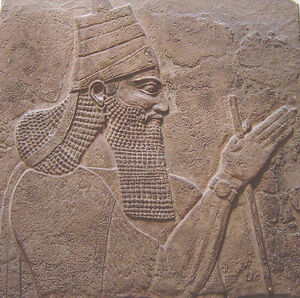Ασσωρονασιπάλης Β' ο Νεώτερος


Ασσύριοι
Ηγεμόνες Ασσυρίας
---
>>Αρχαιο-Ασσυριακή<<
Δυναστεία 1η
Δυναστεία 2η
>>Παλαιο-Ασσυριακή<<
Δυναστεία 3η
Δυναστεία 4η
Δυναστεία 5η
>>Μέσο-Ασσυριακή<<
Δυναστεία 6η
Δυναστεία 7η
Δυναστεία 8η
>>Νεο-Ασσυριακή<<
Δυναστεία 9η
Δυναστεία 10η
---
Βαβυλωνία
Βαβυλώνιοι
Ηγεμόνες Βαβυλωνίας
---
Ισίνεια (Isin)
Ηγεμόνες Ισίνειας
Λάρισα (Larsa)
Ηγεμόνες Λάρισας
---
Σουμερία (Sumer)
Σουμέριοι
Ηγεμόνες Σουμερίας
---
Ακκαδία (Akkad)
Ακκάδιοι
Ηγεμόνες Ακκαδίας
---
Ελυμαΐδα (Elam)
Ελυμαίοι
Ηγεμόνες Ελυμαΐδας
---
Εσνύννεια (Esnunna)
Ηγεμόνες Εσνύννειας
Μάρεια (Mari)
Ηγεμόνες Μάρειας
---
Μιταννία (Mitanni)
Μιταννοί
Ηγεμόνες Μιταννίας
- Βασιλέας της Ασσυρίας (883 – 859 π.Χ.)
- Χρονική Περίοδος Διακυβέρνησης: Νεο-Ασσυριακή Εποχή,
- Γέννηση:
- Θάνατος:
Ετυμολογία[]
| της Ασσυρίας
|
|---|
| Νεότερη Περίοδος |
Adad-nirari II
|
Tukulti-Ninurta II
|
Ashur-nasir-pal II
|
Shalmaneser III
|
Shamshi-Adad V
|
Adad-nirari III
|
Sammu-ramat
|
Shalmaneser IV
|
Ashur-Dan III
|
Ashur-nirari V
|
Tiglath-Pileser III
|
Shalmaneser V
|
Sargon II
|
Sennacherib
|
Esarhaddon
|
Ashurbanipal
|
Ashur-etil-ilani
|
Sin-shumu-lishir
|
Sin-shar-ishkun
|
Πτώση Νινευίδας,
|
Ashur-uballit II
|
Πτώση Χαρράνειας
|
Το όνομα "Ashur-nasir-pal" είναι εξελληνισμός του Ασσυριακού ονόματος "[[]]".
Γενεαλογία[]
- Οίκος:
- Πατέρας:
- Μητέρα:
- Σύζυγος:
- Τέκνα:
Βιογραφία[]
- Τα σημαντικότερα ιστορικά γεγονότα, κατά την διάρκεια του βίου του, είναι:
Immediately upon assuming power, Ashurnasirpal warred against and suppressed the hill tribes north of the Tigris River in what is now Kurdistan.
As soon as his accession year (apparently following directly on the heels of Tukulti-Ninurta II's last campaign) the king brought out his soldiers and chariots for a march through the area of Χαραμηνή (Zamua), (μεταξύ Φύσκου και Κάπρου (Μικρού Ζάβιου)) which stretched east from Nineveh as far as the Zagros foothills, and north up to Lake Urmia. He first conquered the cities of Libe, Surra, Abuqu, Arura, and Arabe. People fleeing from these towns congregated at the peak of a tall mountain, which the annals describe with the oft-quoted phrase: "like the point of an iron dagger, which no bird reaches". As was often the case for campaigns in these regions, the land was not suitable for chariots and large formations of men, a hinderance which may be masked behind the king's statement that only three days later were his soldiers able to climb the mountain peak and engage the enemy (883)
The next area of this first, brief campaign were the Αρσαζηνή ( = lands of Kirurri and Kirhu, which lay in the upper Tigris Valley north of Nineveh). Several local rulers presented him with tribute, however when he reached the cities lying along the Αρσανίας Ποταμός (= Arzn river), a north-south running tributary of the Tigris west of Lake Van, he proceeded to pillage until reaching the town of Nishtun. There he put the people to flight to a high mountain that "hung over the town like a cloud from heaven". Boasting as a feat none of his fore-fathers had achieved, his soldiers managed to climb the mountain and again defeat the enemy. He renamed Nishtun 'Al Assurnasirpal' (Assurnasirpal City) a testament to his dominion, capped off with a stele of himself set at the source of the river. Most graphically though, as an example to future would-be rebels he took the chief Bubu of Nishtun and flayed him in Arbela, spreading his skin along the city-wall (882)
Ηe thwarted Aramaean pressure on the Assyrian city of Damdamusa by storming the rebel stronghold of Kinabu and ravaging Ναϊρία (the land of Nairi (Armenia)). He organized a new Assyrian province of Tushhan to control the border, and there he received tribute from his father's former opponent Amme-ba'ali.
The next year's campaign (881) was longer and farther-ranging. Returning to where the previous year's campaign left off, at the base of Mt. Nippur and Mt. Pasate, he started off by conquering the Σωφηνή towns of Atkun, Ushhu, Pilazi, and numerous other small towns to the north of Άμιδα (modern Diyarbakır) καθώς και την Tela ( = συγχρ Veranshehr) ( = Αντωνινόπολη Then crossing the Tigris over to the Κομμαγηνή (land of Qummuhi), he received tribute from the troublesome Mashki (Phrygians), at which point he received reports of a rebellion in Suru (backed by the Syrian kingdom of Bit-Adini), along the Habur river. Thus he swooped down from the north, proceeding along the left bank of the river collecting tribute until he reached Suru.
- I approached the city Suru, which belongs to Bit-Halupe. Awe of the radiance of Assur, my lord, overwhelmed them. The nobles (and) elders of the city came out to me to save their lives. They submitted to me and said: 'As is pleases you, kill! As it pleases you, spare. As it pleases you, do what you will!' I captured Ahi-iababa, son of a nobody, whom they brought from the land Bit-Adini. With my staunch heart and fierce weapons I besieged the city. All the guilty soldiers were seized and handed over to me. I sent my nobles into his palace (and) temples. I carried off his silver, gold, possessions, property, bronze, iron, tin, bronze casseroles, bronze pans, bronze pails, much bronze property, gishnugallu-alabaster, an ornamented dish, his palace women, his daughters, captives of the guilty soldiers together with their property, his gods together with their property, precious stone of the mountain, his harnessed chariot, his teams of horses, the equipment of the horses, the equipment of the troops, garments with multi-coloured trim, linen garments, fine oil, cedar, fine aromatic plants, cedar shavings, purple wool, red-purple wool, his wagons, his oxen, his sheep - his valuable tribute which, like the stars of heaven, had no number.
- I appointed Azi-ili as my own governor over them. I erected a pile in front of his gate; I flayed as many nobles as had rebelled against me (and) draped their skins over the pile; some I spread out within the pile, some I erected on stakes upon the pile, (and) some I placed on stakes around the pile. I flayed many right through my land (and) draped their skins over the walls. I slashed the flesh of the eunuchs (and) of the royal eunuchs who were guilty. I brought Ahi-iababa to Nineveh, flayed him, (and) draped his skin over the wall of Nineveh."
Το επόμενο έτος (880) πραγματοποιήθηκε εκστρατεία και πάλι βόρεια από την Μάσια Οροσειρά, στην Σωφηνή, καθώς μία νέα εξέγερση είχε σημειωθεί και οι Αραμαίοι είχαν φονεύσει στην Άμιδα τον σύμμαχο της Ασσυρίας Amm-baal αντικαθιστώντας τον με τον Burramman
Οι Ασσύριοι κατέλαβαν την πόλη έγδαραν τον Burramman και στην συνέχεια εισέβαλαν στην Ναϊρία που λεηλατήθηκε άγρια.
Ακολούθησε (478) συμμαχία των Αραμαίων του Χαβώρα (οι Shuki και οι Lakis) και της Βαβυλωνίας για να καταληφθούν τα Σούρα.
Οι Ασσύριοι εξεστράτευσαν αμέσως στον Ευφράτη και συνέτριψαν τους συμμάχους σε μάχη (478) και στην συνέχεια έφθασαν μέχρι τα σύνορα του Bit-Adini.
He pushed into Syria, defeated Bit-Adini, and crossed the Orontes River, extorting tribute from the cities of Phoenicia during 875 – 874.
His final campaign was a successful expedition against the Kashiari hill tribes, which were in rebellion on the northwest borderlands of Assyria during 866. Τhe tribes in the Kashiari hills revolted and murdered Amme-ba'ali. The Assyrian revenge was swift and ruthless.
910 BC Ashurnasirpal II born as son of Tukulti-Ninurta II.
883 BC Ascends throne after his father. Campaigns to secure borders in north, east and west.
881 BC Starts a campaign against the rebel governor of Nishtun at eastern Arbela.
879 BC Calah founded as new capital after years of rebuilding using slave enemy captives. (Kutmuhu?) (or Bit-Halupe, Κάτω Χαβώρας))
? Bit-Adini, βασιλέας Ahuni
867 BC Mediterranean campaigns succeed. Phoenician kingdoms Tyre, Byblos and Sidon pay tribute.
866 BC Revolt in northern Kashiari hills (Μιταννικά Όρη) leaves vassal Amme-ba'ali dead. Assyria subdues rebels.
859 BC Death.
Υποσημειώσεις[]
Εσωτερική Αρθρογραφία[]
Βιβλιογραφία[]
Ιστογραφία[]
- Ομώνυμο άρθρο στην Βικιπαίδεια
- Ομώνυμο άρθρο στην Livepedia
- Kings of Assyria
- assyrischen Könige
- The Cambridge Ancient History
- History of Egypt, Chaldæa, Syria, Babylonia, and Assyria

Ασσωρονασιπάλης Β'
(Ashurnasirpal II)
|
Αν και θα βρείτε εξακριβωμένες πληροφορίες "Οι πληροφορίες αυτές μπορεί πρόσφατα Πρέπει να λάβετε υπ' όψη ότι Επίσης, |
- Μην κάνετε χρήση του περιεχομένου της παρούσας εγκυκλοπαίδειας
αν διαφωνείτε με όσα αναγράφονται σε αυτήν
- Όχι, στις διαφημίσεις που περιέχουν απαράδεκτο περιεχόμενο (άσεμνες εικόνες, ροζ αγγελίες κλπ.)
